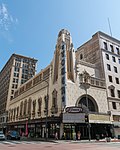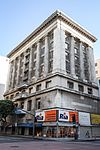Globe Theatre (Los Angeles)

The Globe Theatre, originally the Morosco Theatre, and Garland Building, is an office building and theater at 744 S. Broadway in the Broadway Theater District of the Historic Core of Downtown Los Angeles. It opened in 1913, has 11 stories, and was designed in Beaux-Arts architectural style by the firm of Morgan, Walls & Morgan. Alfred F. Rosenheim designed its interiors. As of 2024 the venue is again closed, but has a capacity of 2,000. The Globe opened in 1913 as the Morosco Theatre with a seating capacity of 782, used for full-scale live dramatic theater, and built for impresario Oliver Morosco. The Garland Building was office space, forming a single building with the theater The Globe was converted into a movie theater during the Great Depression, and later on showed Spanish-language films until the 1980s It was converted into a swap meet in 1987. As of June 2014, the space was being remodeled as an entertainment venue The restored marquee was relit June 24, 2014. and served during the late 2010s and early 2020s as a multipurpose space for music, theatrical events and films, also as a nightclub where D.J.s like Questlove performed, with a capacity of 2,000. The Globe was again permanently closed as of 2023.
Excerpt from the Wikipedia article Globe Theatre (Los Angeles) (License: CC BY-SA 3.0, Authors, Images).Globe Theatre (Los Angeles)
South Broadway, Los Angeles Downtown
Geographical coordinates (GPS) Address Nearby Places Show on map
Geographical coordinates (GPS)
| Latitude | Longitude |
|---|---|
| N 34.044 ° | E -118.254 ° |
Address
Garland Building
South Broadway 740-744
90013 Los Angeles, Downtown
California, United States
Open on Google Maps









